spring boot实现ssm(1)功能
前面完成了ssm的整合, 整个过程可以说很繁杂, 各种配置, 很容易让人晕掉.
这里使用spring boot 的方式来实现 ssm(1) 中的功能.
一. 建项目
1. 使用 idea 来创建 spring boot 项目, 是比较简单的, 如果使用eclipse的话, 要装插件, 比较麻烦, 那这里, 就直接使用idea来做吧
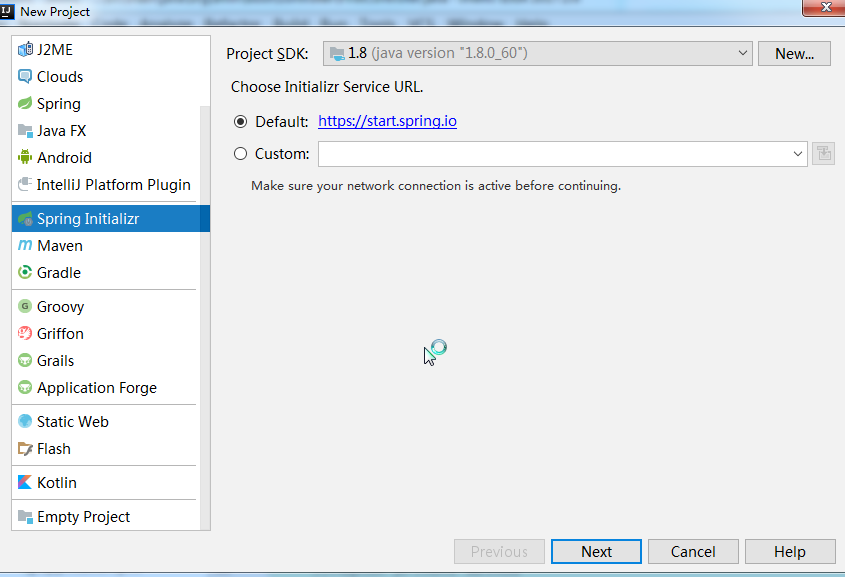
2. 这里只需要修改下面圈出来的部分. Java Version最好使用>=8.
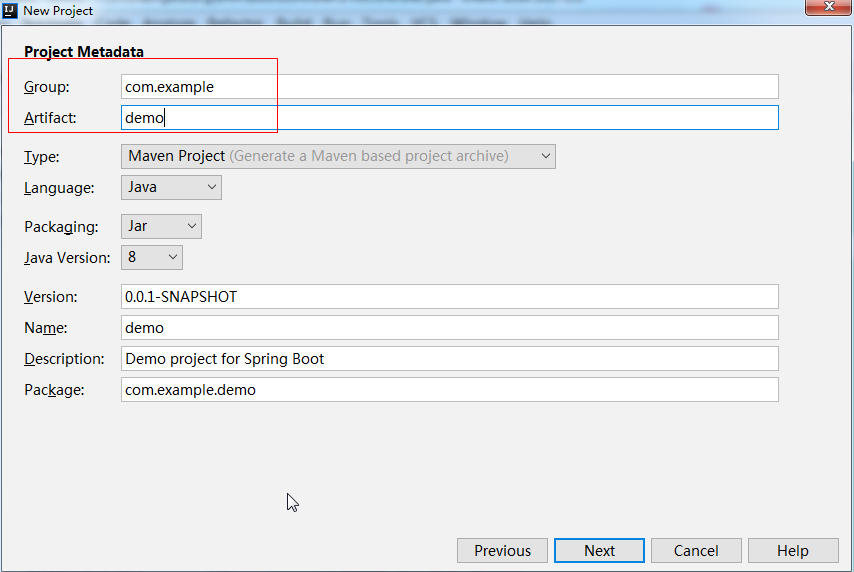
3. 这里直接选择web就可以了, 缺什么, 可以在后面加就好
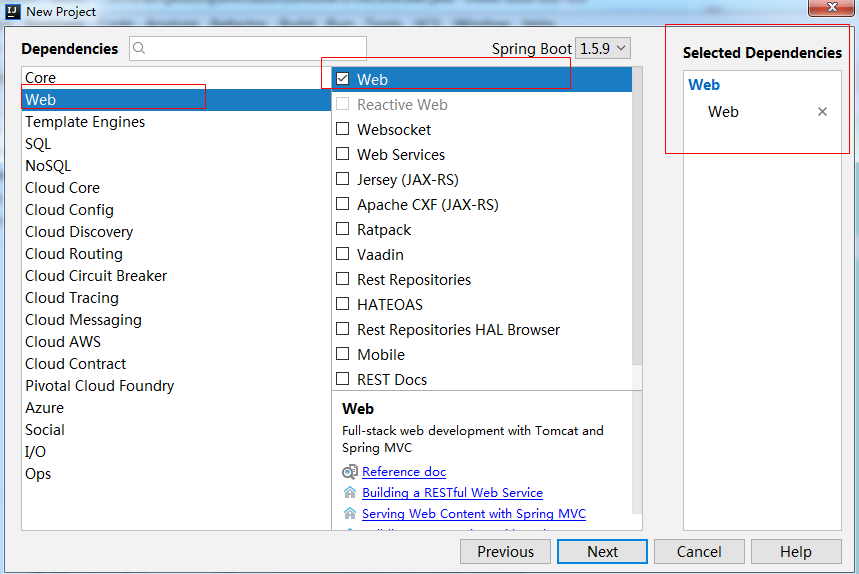
4. 选择路径

经过这么几步操作, 就完成了基本的新建工作.
在新建的过程中, 可能会非常的慢, 因为第一次建, 要下载很多jar包. 而且可能下载还比较慢.
这里可以在maven 的 setting.xml文件中, 加入一个阿里云的镜像, 对于下载更新jar包, 是有帮助的.
<mirrors> <mirror> <id>nexus-aliyun</id> <mirrorOf>*</mirrorOf> <name>Nexus aliyun</name> <url>http://maven.aliyun.com/nexus/content/groups/public</url> </mirror> </mirrors>
二. 目录结构
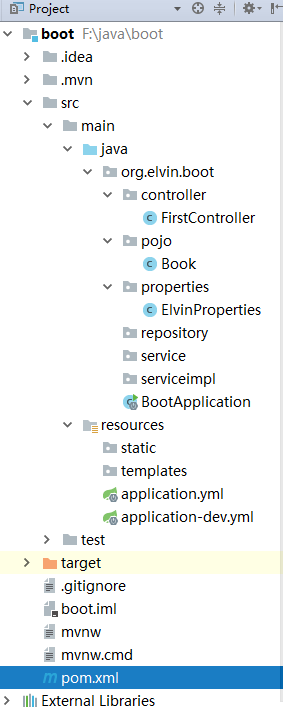
拿到刚建的项目后, 我在里面新增了几个package. 在这里, 除了controller要建之外, 别的都可以先空着.
三. 配置文件 -- 这一步直接跳过, 也是能正常运行的. 不急的话, 就先看看这里把
默认的配置文件是 application.properties, 这里我并没有使用这个格式的文件, 而是使用了 yml 格式的文件, 配置起来, 更加的简洁, 且效果是一样的.
先来看一下application.yml文件
#标明引入那个配置文件
spring:
profiles:
active: dev
#自定义属性
elvin:
name: elvinle
age: 28
birthday: 1990-12-02
#自定义属性
content: "elvin's name is ${elvin.name} and age is ${elvin.age} and birthday is ${elvin.birthday}"
开发的过程中, 可能会部署到好几个环境, 比如开发环境, 测试环境, 那么这里的spring.profiles.active就起作用了, 可以新建多个文件, 这里配置, 后面使用哪个文件的配置.
再来看看application-dev.yml文件
#配置项目端口和根路径 server: port: 8080 context-path: /boot spring: #配置项目的数据库链接信息 datasource: driver-class-name: com.mysql.jdbc.Driver url: jdbc:mysql:///test?useUnicode=true&characterEncoding=utf-8 username: root password: root jpa: hibernate: ddl-auto: update show-sql: true
server.port 和 server.context-path 分别表示端口和根路径. 它们都是可以不配置的. 后面的配置, 暂时不用看
在这两个文件中, 可以看到, 我定义了自己的属性. 那么他们怎么接收呢
在目录中, 有个properties的文件夹, 我在里面建了个类来接收
package org.elvin.boot.properties; import org.springframework.boot.context.properties.ConfigurationProperties; import org.springframework.stereotype.Component; /** * author: Elvin * Date: 2017/12/4 15:10 * Description: */ @Component @ConfigurationProperties(prefix = "elvin") public class ElvinProperties { private String name; private Integer age; private String birthday; public String getName() { return name; } @Override public String toString() { return "Elvin{" + "name='" + name + '\'' + ", age=" + age + ", birthday='" + birthday + '\'' + '}'; } public void setName(String name) { this.name = name; } public Integer getAge() { return age; } public void setAge(Integer age) { this.age = age; } public String getBirthday() { return birthday; } public void setBirthday(String birthday) { this.birthday = birthday; } }
使用的地方在controller中.
四. 实体类
package org.elvin.boot.pojo; /** * author: Elvin * Date: 2017/12/4 15:37 * Description: */ public class Book { private Integer id; private String name; private String publishTime; private Integer price; @Override public String toString() { return "Book{" + "id=" + id + ", name='" + name + '\'' + ", publishTime='" + publishTime + '\'' + ", price=" + price + '}'; } public Integer getId() { return id; } public void setId(Integer id) { this.id = id; } public String getName() { return name; } public void setName(String name) { this.name = name; } public String getPublishTime() { return publishTime; } public void setPublishTime(String publishTime) { this.publishTime = publishTime; } public Integer getPrice() { return price; } public void setPrice(Integer price) { this.price = price; } }
这里实体类就随便建一下了, 这里还不是他的完全体, 在下一篇, 会进行部分修改
五. controller
package org.elvin.boot.controller; import org.elvin.boot.pojo.Book; import org.elvin.boot.properties.ElvinProperties; import org.joda.time.DateTime; import org.springframework.beans.factory.annotation.Autowired; import org.springframework.beans.factory.annotation.Value; import org.springframework.web.bind.annotation.GetMapping; import org.springframework.web.bind.annotation.PostMapping; import org.springframework.web.bind.annotation.RequestMapping; import org.springframework.web.bind.annotation.RestController; import java.util.*; /** * author: Elvin * Date: 2017/12/4 15:08 * Description: */ @RestController @RequestMapping("first") public class FirstController { @Autowired private ElvinProperties elvinProperties; //接收配置文件中,自定义的content属性 @Value("${content}") private String content; @GetMapping("properties") public Map<String, Object> properties(){ Map<String, Object> map = new HashMap<>(); map.put("content", content); map.put("elvinProperties", elvinProperties); return map; } @PostMapping("all") public List<Book> all() { return getBookList(); } //region private method private List<Book> getBookList() { List<Book> bookList = new ArrayList<>(); String[] nameStrs = {"吴", "一", "雪", "动", "额", "阿", "前", "里", "排"}; Random r = new Random(); String timeStr = new DateTime().toString("yyyy-MM-dd HH:mm:ss"); for (int i = 0; i < 10; i++) { Book b = new Book(); b.setId(i + 1); b.setName(nameStrs[r.nextInt(5)] + nameStrs[r.nextInt(9)]); b.setPublishTime(timeStr); b.setPrice(r.nextInt(100)); bookList.add(b); } return bookList; } //endregion }
如果是做前后端分离的话, 那么到这里, 就告一段落了. 先来看看访问结果吧.
六. 结果(前后端分离)
1. 使用postman发送get请求
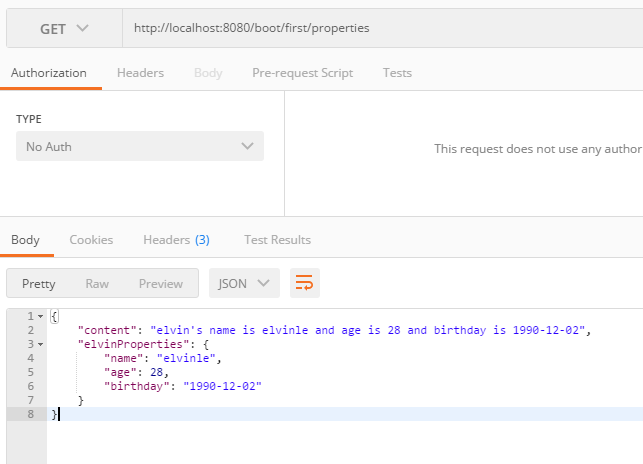
这里可以看到, 自定义配置, 都能够正常获取到
2. 使用postman来发送post请求.

如果还是希望使用返回页面数据的方式, 则还要继续一步配置.
个人还是推荐使用前后端分离的开发方式的. 怎么说呢, 大家都知道, mvc中的v指的就是视图, 在mvc中, 是需要读取视图, 然后解析视图, 最后返回解析完的视图数据的. 过程还是比较复杂和繁琐的, 而且这部分的逻辑处理, 全都在服务器端完成, 即使这里使用了缓存, 对服务器还是有性能损耗的. 如果把这部分损耗转嫁到客户端的浏览器中去, 可以节省不少的性能和空间.
七. view
1. 在pom.xml中, 加入一个配置.
<dependency> <groupId>org.springframework.boot</groupId> <artifactId>spring-boot-starter-thymeleaf</artifactId> </dependency>
这里引入的是 Spring boot 推荐使用的 thymeleaf 模板, 和freemarker, jsp 功能是差不多的
2. 开发状态下, 去yml文件中, 修改下缓存配置
spring:
thymeleaf:
cache: false
#以下都是默认配置,可以不写
prefix: /templates/
suffix: .html
mode: HTML5
encoding: UTF-8
content-type: text/html
3. controller

在包里面重新建一个控制器文件 TwoController.
package org.elvin.boot.controller; import org.elvin.boot.pojo.Book; import org.joda.time.DateTime; import org.springframework.stereotype.Controller; import org.springframework.ui.Model; import org.springframework.web.bind.annotation.GetMapping; import org.springframework.web.bind.annotation.RequestMapping; /** * author: Elvin * Date: 2017/12/4 16:35 * Description: */ @Controller @RequestMapping("two") public class TwoController { @GetMapping("hello") public String hello(Model model){ model.addAttribute("hello", "TwoController.hello()"); return "hello"; } @GetMapping("index") public String index(){ return "/two/index"; } @GetMapping("detail") public String detail(Model model){ Book book = new Book(); book.setName("book"); book.setId(1); book.setPrice(110); book.setPublishTime(new DateTime().toString("yyyy-MM-dd")); model.addAttribute("book", book); return "two/detail"; } }
4. view
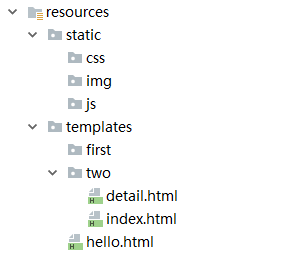
我这里建了三个 html 文件, hello和index就不看了, 里面没有什么内容, 主要看detail.html文件
<!DOCTYPE html> <html xmlns:th="http://www.thymeleaf.org"> <head> <title>detail</title> </head> <body> <h1 th:inline="text">two/detail.html</h1> <p th:text="${book.id}"></p> <p th:text="${book.name}"></p> <p th:text="${book.price}"></p> <p th:text="${book.publishTime}"></p> </body> </html>
5. 结果
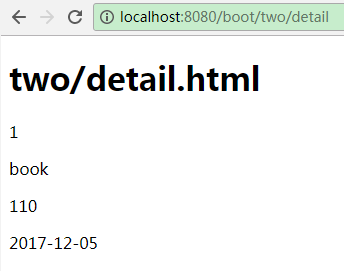
八. 配置文件
做完了这么多, 来看看pom.xml文件吧
<?xml version="1.0" encoding="UTF-8"?> <project xmlns="http://maven.apache.org/POM/4.0.0" xmlns:xsi="http://www.w3.org/2001/XMLSchema-instance" xsi:schemaLocation="http://maven.apache.org/POM/4.0.0 http://maven.apache.org/xsd/maven-4.0.0.xsd"> <modelVersion>4.0.0</modelVersion> <groupId>org.elvin</groupId> <artifactId>boot</artifactId> <version>0.0.1-SNAPSHOT</version> <packaging>jar</packaging> <name>boot</name> <description>Demo project for Spring Boot</description> <parent> <groupId>org.springframework.boot</groupId> <artifactId>spring-boot-starter-parent</artifactId> <version>1.5.9.RELEASE</version> <relativePath/> <!-- lookup parent from repository --> </parent> <properties> <project.build.sourceEncoding>UTF-8</project.build.sourceEncoding> <project.reporting.outputEncoding>UTF-8</project.reporting.outputEncoding> <java.version>1.8</java.version> </properties> <dependencies> <dependency> <groupId>org.springframework.boot</groupId> <artifactId>spring-boot-starter-web</artifactId> </dependency> <dependency> <groupId>joda-time</groupId> <artifactId>joda-time</artifactId> <version>2.6</version> </dependency> <dependency> <groupId>org.springframework.boot</groupId> <artifactId>spring-boot-starter-test</artifactId> <scope>test</scope> </dependency> <dependency> <groupId>org.springframework.boot</groupId> <artifactId>spring-boot-starter-thymeleaf</artifactId> </dependency> </dependencies> <build> <plugins> <plugin> <groupId>org.springframework.boot</groupId> <artifactId>spring-boot-maven-plugin</artifactId> </plugin> </plugins> </build> </project>
本身就不多的pom文件里面, 绝大部分都是spring boot 自己生成的, 只有 joda-time 和 thymeleaf 是我手动添加的.
从这里的pom文件上看, 少了绝大部分的jar包引用, 十分的方便.
而项目中的yml配置, 如果只是使用最基本的功能, 可以一个都不配置, 照样跑的好好的.




